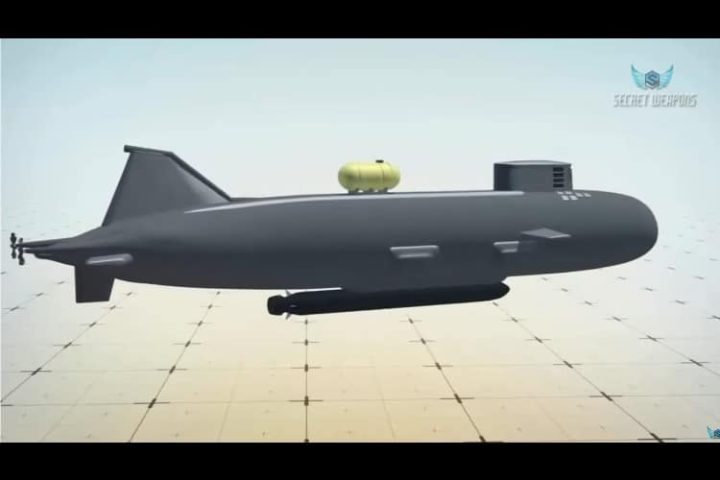
The threat of nuclear holocaust once figured prominently in our psyches. In the 1950s, schoolchildren did duck-and-cover drills to prepare for atomic attack. The 1983 film The Day After, portraying a nuclear exchange and its hopeless aftermath, terrified audiences and created pressure for disarmament talks. Yet while the Cold War’s end has allayed these fears, the famed “Doomsday Clock” is still the closest to midnight it has ever been: 100 seconds to apocalypse. And one reason why may be what some have dubbed Russia’s “doomsday weapon.”
It’s called Poseidon, and it’s not just the stuff of your grandfather’s atomic nightmares. The average nuclear weapon is a missile-delivered device that could destroy a city and, in the most formidable warheads’ cases, a great deal of area beyond. Poseidon, however, is a huge nuclear torpedo that, some say, could destroy a whole continent.
There is disagreement, though, on the weapon’s true formidability and level of completion. As WND.com reported Sunday:
Is it high-stakes gamesmanship — or just a bluff?
It was back in 2015 that images of a Russian nuclear torpedo first emerged on state television.
It didn’t raise much attention in the West.
But since then, with Moscow on the march toward war, it’s raising the question why Russia has constructed a deadly weapon that could eradicate all life on this planet.
… The new bomb is said to use a warhead much stronger [than that of the U.S.’s Minutemen III nuclear weapon], perhaps the largest one ever detonated.
Website 1945 provided more detail, reporting on the weapon in September 2021, writing:
The Russian Navy’s fearsome Poseidon torpedo is not only nuclear-armed, but it is also nuclear-powered. And it is massive — estimated at around 7 feet in diameter and around 100 tons, the torpedo foregoes a conventional high-explosive warhead in favor of a nuclear payload. By comparison, one of the United States Navy’s standard heavy-weight torpedos [sic], the Mark 48, is a paltry 21 inches in diameter and about 3,500 pounds.
Unlike most conventional torpedoes, the Poseidon’s primary target wouldn’t necessarily be a surface ship or other submarines. Thanks to the torpedo’s large nuclear warhead, it would instead target large port cities vital to industry and trade — like the many cities that dot the United States’ east and west coasts.
The weapon has another application as well: “targeting US aircraft carriers and their strike groups,” Business Insider informed in 2018. “As it stands, the US doesn’t have a way to defend against fast-moving torpedoes like the Poseidon.”
The device is showcased in the following video, which, do note, was created by the Ministry of Defense of Russia (perhaps for propaganda purposes).
The Insider also elaborated on how the torpedo is unique, writing:
While there’s a risk of radioactivity any time an atom is split, [traditional] nuclear weapons have typically used nuclear detonations to create heat and pressure, with lingering radioactivity emerging only as a dangerous side effect.
But the new Russian torpedo uses radioactive waste to deter, scare, and potentially punish enemies for decades.
“Nuclear weapons only generate significant amounts of radioactive fallout when they are detonated at, near, or beneath ground level,” Stephen Schwartz, the author of “Atomic Audit: The Costs and Consequences of US Nuclear Weapons Since 1940,” told Business Insider.
These types of nuclear explosions “suck up dirt, or water, contaminates it with debris from the bomb, and then lofts it into the atmosphere,” leaving deadly radioactive fallout potentially strewn across thousands of miles, Schwartz said. What’s more, the bomb is rumored to have its nuclear core coated in a metal that would make the fall out last for half a century.
“It’s an insane weapon in the sense that it’s probably as indiscriminate and lethal as you can make a nuclear weapon,” Hans Kristensen, the director of the Nuclear Information Project at the Federation of American Scientists, told Business Insider.
So, assuming the above portrayals are accurate, why would Russia develop such a doomsday device now, long after the Cold War’s end?
Business Insider examined this matter in a Friday piece, writing that Malcolm Davis, a senior analyst at the Australian Strategic Policy Institute
called the Poseidon a “third-strike vengeance weapon” — meaning Russia would attack a NATO member, the US would respond, and a devastated Russia would flip the switch on a hidden nuke that would lay waste to an entire US seaboard.
According to Davis, the Poseidon would give Russia a “coercive power” to discourage a NATO response to a Russian first strike.
Russia here would seek to not only reoccupy Eastern Europe “but coerce NATO to not act upon an Article 5 declaration and thus lose credibility,” he said, referring to the alliance’s key clause that guarantees a collective response to an attack on a member state.
Russian President Vladimir Putin “has made it clear he seeks the collapse of NATO,” Davis continued. “If NATO doesn’t come to the aid of a member state, it’s pretty much finished as a defense alliance.”
Essentially, Russia could use the Poseidon as an insurance policy while it picks apart NATO. The US, for fear that its coastlines could become irradiated for decades by a stealthy underwater torpedo it has no defenses against, might seriously question how badly it needs to save Estonia from Moscow’s clutches.
“Putin may calculate that NATO will blink first rather than risk escalation to a nuclear exchange,” Davis said. “Poseidon accentuates the risks to NATO in responding to any Russian threat greatly, dramatically increasing Russia’s coercive power.”
This said and as mentioned earlier, some sources I’ve read call into question the weapon’s formidability. And one could imagine many different reasons for touting it.
Whether bluff or Beelzebub bomb, Russia’s motivation is obviously to intimidate. As for American motives, some may theorize that war mongers want to portray Moscow as a unique threat that must be aggressively countered; on the other hand, non-interventionists may want to characterize the Bear as a fearsome rival that shouldn’t be poked when no American national interests are at stake. And, then, there could also be some people simply interested in the Truth.
For certain is that ours is an age in which full-scale warfare between great powers must be a thing of the past, or we’ll all be in the past. After all, existing nuclear weapons are already more than capable of laying waste to the entire planet.
As to this, if you’re interested, or if your entertainment tastes tend toward the morbid, check out Nukemap, “an interactive website allowing one to peer into the effects of a nuclear bomb attack for any location on earth” (video below).
The website is here.
Sleep well.



